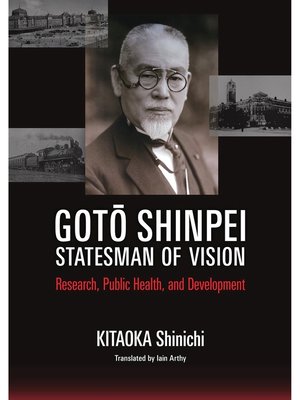Gotō Shinpei, Statesman of Vision: Research, Public Health, and Development
ebook
By Kitaoka Shinichi

Sign up to save your library
With an OverDrive account, you can save your favorite libraries for at-a-glance information about availability. Find out more about OverDrive accounts.
Find this title in Libby, the library reading app by OverDrive.



Search for a digital library with this title
Title found at these libraries:
| Library Name | Distance |
|---|---|
| Loading... |
The Meiji era (1868–1912) produced numerous geniuses in Japan and one who certainly earns his name on the list is Gotō Shinpei.
Gotō, who was a prominent figure in Japan's political scene, showed exceptional talent in various fields. Starting off his career as a physician, he became a leading figure in public health, and successfully organized a massive quarantine in 1895 for returning soldiers of the First Sino-Japanese war. Later he was appointed as civilian governor of Taiwan and following this he became the first president of the South Manchuria Railway, showing ingenuity in colonial management which was remarkably different from that of Western countries. He built the basis of the Japanese railway system as director-general of the Railway Agency, and as the minister of home affairs presented a grand vision for urban planning immediately after the Great Kantō Earthquake of 1923. He never organized a cabinet himself, but has been remembered as a successful leader in public heath, urban planning, infrastructure building, etc.
From his birth in a poor samurai family to his death at seventy-one years old, this biography carefully follows his steps, while at the same time delving into the visions and methods that made him a unique leader.
Gotō, who was a prominent figure in Japan's political scene, showed exceptional talent in various fields. Starting off his career as a physician, he became a leading figure in public health, and successfully organized a massive quarantine in 1895 for returning soldiers of the First Sino-Japanese war. Later he was appointed as civilian governor of Taiwan and following this he became the first president of the South Manchuria Railway, showing ingenuity in colonial management which was remarkably different from that of Western countries. He built the basis of the Japanese railway system as director-general of the Railway Agency, and as the minister of home affairs presented a grand vision for urban planning immediately after the Great Kantō Earthquake of 1923. He never organized a cabinet himself, but has been remembered as a successful leader in public heath, urban planning, infrastructure building, etc.
From his birth in a poor samurai family to his death at seventy-one years old, this biography carefully follows his steps, while at the same time delving into the visions and methods that made him a unique leader.







